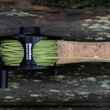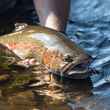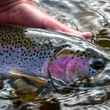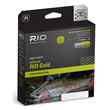There are distinct advantages offered by fast action rods that don't come in slower packages. They allow for easy and authoritative line pickup, have the ability to toss heavy lines and tips, are much more adept at casting in the wind, allow the caster to throw tighter loops, generally help increase aim and accuracy and -- of course -- pack more power than their slower bretheren, allowing for longer and quicker casts. Despite all of these advantages, I've made no secret of the fact that I'm not generally a fast-action rod fan.
I've criticized rod makers for taking the fast-action trend too far and many a fly fisherman for buying into the idea that fast action rods are the best rod for virtually any job. Though the advantages of fast-action rods are numerous, those advantages have always been accompanied by tradeoffs, tradeoffs which have come in the form of decreased responsiveness or feel, poor performance in close and increased difficulty of casting. All of these tradeoffs, for the most part, are symptoms of the same characteristic of fast-action rods: their stiffness and tendency towards tip-flex.





























